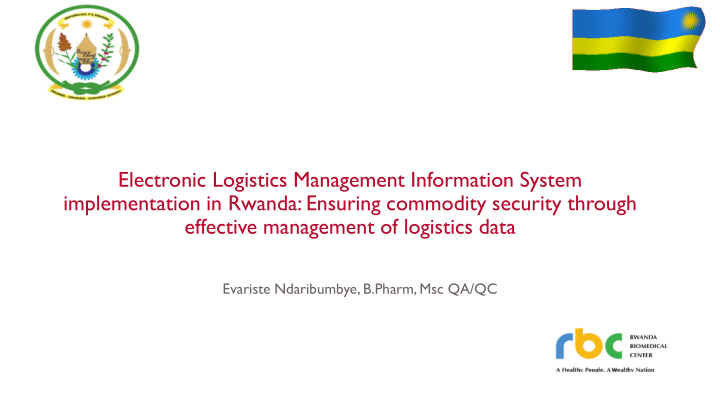



Electronic Logistics Management Information System implementation in Rwanda: Ensuring commodity security through effective management of logistics data Evariste Ndaribumbye, B.Pharm, Msc QA/QC
Background • Quality and timely logistics data is essential for efficient supply chain management for public health commodities • Since 2010, Rwanda has been using harmonized paper based LMIS • Challenges in the use of the paper-based system for the health LMIS included data accuracy, timeliness and feedback response time • To address these challenges, the Ministry of health with the support from the Global Fund and USAID through the USAID Global Health Supply Chain Program- Procurement and Supply Management (GHSC-PSM) project implemented an e-LMIS to provide real-time inventory data, order visibility, coordinated order processing and warehouse management functionalities • The e-LMIS was rolled out in 2014 to replace the paper-based LMIS reporting system
Objective To share how using an electronic logistics management information system (e-LMIS) has improved real time data visibility to inform decision making
Methodology • In 2012, the MOH and partners (Global Fund and USAID) gathered eLMIS functional and system requirements • In 2014, a phased approach was taken to roll out the system countrywide to 559 service delivery points (SDPs), 30 district pharmacies (DPs) and the central level warehouse store o Medical Procurement Production Division (MPPD) • Process orders from DPs and referral hospitals o District Pharmacies (DPs) • Order and receive commodities from the central medical store • Process orders from Service Delivery Points (SDPs). o Service Delivery Points (SDPs) • Use the e-LMIS to place and receive monthly orders for health commodities from DPs • Record daily consumption data from health commodity registers dispensed to the patients
e-LMIS process operations REPLENISHMENT/ ORDERING AND QUANTIFICATION: A E SHIPPING: Role based: Based on consumption, Requires various approvals running the replenishment and collaboration on engine. orders DATA ANALYSIS: Reports and graphics: RECEPTION AND B D Facilitate decision PUT AWAY. Move making for improvement items to appropriate location, cold room, room temperature Key functions: C Order management, inventory management, warehouse management, transportation management RECORD TRANSACTIONS: Consumption/Distribution, and supply and demand planning. adjustments Serialized item and lot tracking. Supply chain-wide shipment visibility, with event notifications. Integration with existing WMS ERP (Sage L500) and DHIS2 (HMIS). 6639 SKU Items 2026 active e-LMIS users
Results • Accurate e-LMIS data are increasingly used by the Ministry of Health and partners to: o Track key supply chain indicators o Inform strategic activities in health supply chain management o To inform decision making
Results
Conclusions • The e-LMIS has significantly strengthened health commodity management by automating supply chain and logistics processes from central level to service delivery points. • Data visibility is readily available for decision makers to strategize supply chain interventions. • Much as e-LMIS is a success story in the supply chain for health commodities in Rwanda, it continues to be work in progress with emphasis on monitoring and sustainability required
Evariste Ndaribumbye, B.Pharm, MSC QA/QC Medical Supply Chain Coordination Officer Ministry of Health evariste.ndaribumbye@moh.gov.rw
Recommend
More recommend